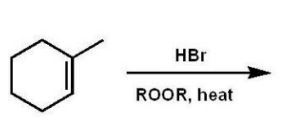A) prevent oxidation reactions
B) form less reactive radicals
C) destroy reactive radicals
D) include hydroquinones and vitamins A and E
E) do all of the above
G) A) and C)
Correct Answer

verified
Correct Answer
verified
Multiple Choice
Rank the radicals in order from most stable to least stable. 
A) 1>2>3>4
B) 4>3>2>1
C) 3>4>2>1
D) 1>2>4>3
E) 4>2>3>1
G) A) and C)
Correct Answer

verified
Correct Answer
verified
Multiple Choice
Which compound will be the major product of the following radical
Addition reaction?

A) ![]()
B) ![]()
C) ![]()
D) ![]()
E) ![]()
G) A) and E)
Correct Answer

verified
Correct Answer
verified
Multiple Choice
Which of the following radicals is the most stable?
A) ![]()
B) ![]()
C) ![]()
D) ![]()
E) ![]()
G) A) and B)
Correct Answer

verified
Correct Answer
verified
Multiple Choice
How many isomers are formed in the radical addition of HBr to 1-methylcyclohexene?

A) 1
B) 2
C) 3
D) 4
E) 6
Two new asymmetric centers are created in the product.
G) B) and E)
Correct Answer

verified
D
Correct Answer
verified
Multiple Choice
Calculate the percentage yield of the product below formed by radical bromination. [Relative reactivities: 1°(1) , 2°(82) , 3°(1600) ] ![Calculate the percentage yield of the product below formed by radical bromination. [Relative reactivities: 1°(1) , 2°(82) , 3°(1600) ] A) 5% B) 15% C) 29% D) 41% E) 71%](https://d2lvgg3v3hfg70.cloudfront.net/TBP1106/11ef27fc_c1bc_2773_aec8_e9f0a9aec25a_TBP1106_00.jpg)
A) 5%
B) 15%
C) 29%
D) 41%
E) 71%
G) A) and B)
Correct Answer

verified
Correct Answer
verified
Multiple Choice
Which compound will give one product upon radical bromination using NBS, ROOR, and heat?
A) ![]()
B) ![]()
C) ![]()
D) ![]()
E) ![]()
G) B) and E)
Correct Answer

verified
Correct Answer
verified
Multiple Choice
What is the first step in the radical halogenation of an alkane?
A) abstraction
B) initiation
C) propagation
D) combination
E) termination
G) A) and C)
Correct Answer

verified
B
Correct Answer
verified
Multiple Choice
Of the following ethers, which would be least likely to form peroxides and hence be safer to use in a laboratory?
A) ![]()
B) ![]()
C) ![]()
D) ![]()
E) ![]()
G) D) and E)
Correct Answer

verified
Correct Answer
verified
Multiple Choice
How many monobrominated constitutional isomers are possible for the following reaction? 
A) 2
B) 3
C) 4
D) 5
E) 6
G) A) and B)
Correct Answer

verified
D
Correct Answer
verified
Showing 1 - 10 of 10
Related Exams